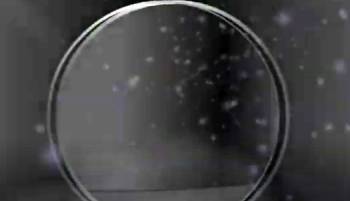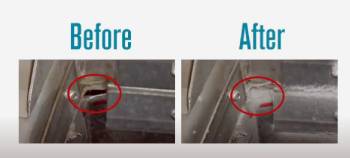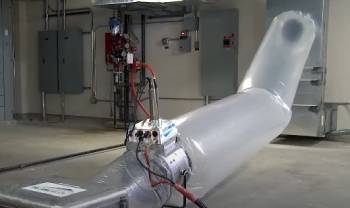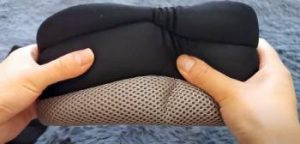If your home’s HVAC system is leaking air, you’re wasting energy and money. Aeroseal duct sealing is the fix you need, sealing leaks from the inside with a non-toxic aerosol mist.
It boosts efficiency, cuts utility bills, and improves air quality, all without tearing up your walls.
With a 10-year warranty and proven results, it’s a smart investment for comfort and savings.
Trust me, Aeroseal is a game-changer for any homeowner—get it done and enjoy a cozier, cheaper-to-run home today.
My Journey with Aeroseal Duct Sealing

I never paid much attention to my ductwork until my house started feeling like a patchwork of climates—swelteringly unbearable in the living room, arctic in the bedroom.
My energy bills were climbing, and my HVAC system sounded like it was working overtime.
A neighbor raved about Aeroseal duct sealing, and though I was skeptical about a mist magically fixing leaks, I was fed up enough to try it.
The process was surprisingly smooth. A certified technician came to my house, sealed off the vents, and hooked up a machine to my furnace.
They pressurized the system and sprayed this aerosol sealant that finds and plugs leaks like a heat-seeking missile.
It took about four hours, and I got a report showing my duct leakage dropped from 320 CFM to 45 CFM—an 86% improvement.
Within a week, my home felt balanced, with no more hot or cold spots.
My allergies, which used to flare up constantly, calmed down, probably because the ducts weren’t sucking in attic dust.
Three months in, my energy bill’s down $60 a month, and my HVAC runs quieter.
The $4,200 price tag hurt, but the comfort and savings are paying off, and I’m wishing I’d done this years ago.
What Makes Aeroseal Duct Sealing Special?
Aeroseal is a cutting-edge duct sealing technology that uses a non-toxic, water-based vinyl polymer sealant to close leaks from the inside.
The process pressurizes your duct system and injects an aerosol mist that targets leaks up to 5/8 inch, sealing them by bonding to the edges.
It can reduce duct leakage by up to 95%, making your HVAC system more efficient, lowering energy costs, and improving indoor air quality.
It’s ideal for hard-to-reach ducts where traditional methods like tape or mastic fall short.
With a 10-year warranty and durability tested to last over 40 years, Aeroseal offers a long-term fix for homes, offices, and even sensitive environments like hospitals.
Maintenance Tips for Getting the Most Out of Aeroseal Duct Sealing

- Schedule Annual HVAC Inspections: Keep your system running smoothly with yearly checkups. I have a technician inspect my ducts annually to catch any new leaks or issues that could stress the Aeroseal seals, ensuring long-term performance.
- Replace Filters Regularly: Clogged filters make your HVAC work harder, potentially loosening seals. I swap my filter every 2-3 months to keep airflow clean and maintain the sealant’s effectiveness, especially since my allergies are sensitive.
- Monitor System Pressure: Avoid running your HVAC at max capacity all the time—it can strain the seals. I set my thermostat to a consistent temperature, which keeps the system efficient without over-pressurizing the ducts.
- Ensure Clean Ducts Beforehand: Dirty ducts can sabotage the sealant. I learned this when my technician required a cleaning before sealing. If you’re planning Aeroseal, get a professional duct cleaning first for a stronger bond.
- Look for Energy Rebates: Check for utility or government rebates to offset the cost. I found a $350 rebate through my energy provider, which softened the blow. Research local incentives to make Aeroseal more affordable.
My Results and Reflections
Three months after Aeroseal, my home is a different place. The temperature is consistent—no more sweating in one room while freezing in another.
My energy bills are down $60 a month, a 20% drop, and I’m on track to recoup the $4,200 cost in about three years.
My HVAC runs less, saving wear and tear, and the quieter operation is a nice bonus.
My allergies are under control, likely because the ducts aren’t pulling in attic dust anymore.
The 86% leakage reduction feels like a total system overhaul.
That said, Aeroseal isn’t perfect. The upfront cost was a gut punch, and the extra duct cleaning fee caught me off guard.
It’s not a fix for broken ducts, so you might need additional repairs first. The professional-only installation means you’re at the mercy of contractor schedules and pricing.
Still, the comfort, savings, and air quality improvements are undeniable. I’ve started changing filters religiously and booked my next HVAC checkup to keep the seals pristine.
If your ducts are leaking, Aeroseal is a worthwhile splurge—just budget for it and prep your system right.
Pros and Cons of Aeroseal Duct Sealing

Pros:
- Significant Energy Savings: Aeroseal cut my duct leakage by 86%, and my energy bills dropped by about 20%. By sealing leaks, it ensures your HVAC isn’t wasting air, potentially saving up to 30% on heating and cooling costs.
- Enhanced Indoor Air Quality: Leaky ducts pull in dust, pollen, and allergens from attics or crawlspaces. After Aeroseal, my allergies eased up noticeably, and the air feels cleaner, thanks to fewer contaminants sneaking through.
- Non-Disruptive Installation: No demolition needed. The technician worked through existing vents, leaving my home untouched. I was back to my day in hours, with no mess or cleanup to deal with.
- Eliminates Temperature Inconsistencies: Hot and cold spots vanished. My living room and bedroom are now the same cozy temp, and my HVAC runs less, making my home more comfortable and efficient.
- Long-Term Durability: Backed by a 10-year warranty, the seals are tested to last over 40 years without cracking. My system feels like it got a permanent upgrade, giving me confidence in its longevity.
Cons:
- Steep Initial Cost: At $4,200 for my 2,000-square-foot home, Aeroseal’s price made me wince. Costs can range from $1,500 to $6,000, and it takes time to recoup through energy savings, which might deter budget-conscious folks.
- Limited to Smaller Leaks: Aeroseal seals leaks up to 5/8 inch but can’t fix broken or disconnected ducts. My system was in decent shape, but major damage requires separate repairs, adding to the expense.
- Professional Installation Only: You need a certified technician with specialized equipment, so no DIY savings. I wished I could’ve cut costs by doing it myself, but the process is too complex for amateurs.
- Pre-Cleaning Required: Dirty ducts or standing water can weaken the seal. I had to shell out $250 for a duct cleaning first, which wasn’t planned and made the whole thing pricier than expected.
Also Read: My Thoughts On SYNOSHI Power Spin Scrubber
Aeroseal Vs. Other Duct Sealing Methods
- Aeroseal Vs. Manual Duct Sealing with Mastic
I’ve seen manual duct sealing with mastic on a friend’s HVAC system, where technicians apply a gooey sealant to accessible joints and seams. It’s cheaper, costing $500-$1,500, and effective for visible leaks, but it’s labor-intensive and can’t reach hidden ducts like Aeroseal does.
Mastic sealed my friend’s system decently, but he still had minor leaks in tight spots. Aeroseal’s aerosol mist sealed 86% of my leaks, including those deep in the system, with no mess. Manual sealing is budget-friendly but less thorough, making Aeroseal the better choice for comprehensive results.
- Aeroseal Vs. Duct Tape and Foil Tape
I tried duct tape on a leaky vent years ago (big mistake). Duct tape and foil tape are cheap, around $10-$30, and easy to apply to exposed ducts, but they’re a temporary fix. My tape peeled off in months, letting air escape again.
Foil tape holds better but still degrades over time and can’t address internal leaks. Aeroseal’s mist sealed every nook of my system, delivering a permanent 10-year solution. Tape’s fine for quick patches, but Aeroseal’s durability and coverage make it the superior long-term investment.
- Aeroseal Vs. Spray Foam Insulation
Spray foam insulation, which I explored for a rental property, seals ducts while insulating, costing $1,000-$3,000. It’s great for adding thermal protection but messy, requiring duct access and professional application.
My rental’s ducts were partially sealed, but foam couldn’t reach tight spaces like Aeroseal’s mist did in my home. Foam also risks clogging vents if misapplied, while Aeroseal’s non-toxic sealant is precise and safe. For pure duct sealing, Aeroseal’s efficiency and non-invasive process outshine spray foam’s broader but less targeted approach.
Also Read: My Thoughts On Hoover PowerDash Pet Compact Carpet Cleaner
Frequently Asked Questions (FAQs)
Aeroseal costs $1,500-$6,000, depending on home size and duct condition. My 2,000-square-foot home was $4,200, including cleaning. Costs vary by region and contractor, but rebates can help offset the price.
Yes, it’s highly effective. It reduced my duct leakage by 86%, cut energy bills by 20%, and eliminated hot/cold spots. Studies show up to 95% leakage reduction, making HVAC systems more efficient and homes more comfortable.
Aeroseal’s seals come with a 10-year warranty and are tested to last over 40 years without cracking or degrading. My system’s still perfect after three months, and I expect decades of performance.
Manual sealing with mastic ($500-$1,500) is a cheaper alternative, effective for accessible leaks but less thorough. Duct tape or foil tape is a temporary, low-cost fix but degrades quickly. Spray foam insulates and seals but is messier and less precise.
Final Thoughts
Aeroseal duct sealing is a must for anyone with leaky ducts eating up energy and comfort. Its non-invasive, non-toxic mist seals leaks with up to 95% effectiveness, slashing bills and boosting air quality.
The 10-year warranty and 40-year durability make it a long-term win. Yes, it’s pricey, but the savings and cozy home are worth it.
Get Aeroseal done and transform your HVAC system—you’ll wish you’d done it sooner.



